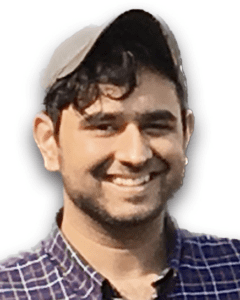Posted By: HGG Advances
Each month, the editors of Human Genetics and Genomics Advances interview an early-career researcher who has published work in the journal. This month we check in with Vamsee Pillalamarri (@vkpillal) to discuss his paper “Whole-exome sequencing in 415,422 individuals identifies rare variants associated with mitochondrial DNA copy number”.

-
What motivated you to start working on this project?
Over billions of years of evolution since their endosymbiotic origin, mitochondria have ceded the genetic code that controls most of their form and function to the nuclear genome. What was fascinating to me is that mitochondria retained a small circular genome (mtDNA) that occurs in variable ploidy across cells and individuals which reflects the core mitochondrial function of cellular respiration and is associated with aging related traits and disease including Mendelian mtDNA depletion syndromes. We previously found that common nuclear genetic variants affect the average number of the copies of mtDNA (mtDNA copy number or mtDNA-CN), but much of the heritability was seemingly unexplained, so we wondered whether rare variants of higher effect drove this complex trait. - What about this paper/project most excites you?
I am most excited that we found evidence of a rare, ancestral shared haplotype associated with mtDNA-CN. In fact, the most significant single nucleotide association was with a pair of rare variants separated by 1.2 Mb on chromosome 20 occurring in 262 of the 415,422 individuals we studied, and we fine-mapped the effect on mtDNA-CN solely to one of the variants, a missense variant in SAMHD1, indicating the other variant’s effect on mtDNA-CN was due to its linkage disequilibrium to the missense variant in SAMHD1. This was surprising since we would normally expect rare variants to be in linkage equilibrium and thus have independent effects. I was thrilled to later realize that this ancestral haplotype was likely persistent in this population because it sits within a region of very low recombination originally delineated in the chromosome 20 reference sequencing paper. So, it was a serendipitous finding that was somewhat obvious in hindsight, but I think it also opens exciting questions about the impact of rare haplotype sharing on complex traits in general that could perhaps be probed within large biobank-scale datasets. - What do you hope is the impact of this work for the human genetics community?
I hope our work sheds further insight into the nuclear genetic architecture of mtDNA copy number, especially with respect to understanding the impact of mtDNA-CN on disease. I also hope our work demonstrates the usefulness of studying rare variants discovered in large biobanks to help elucidate the complex mtDNA-CN trait, that it motivates the consideration of rare haplotype sharing in large, outbred population-based studies for the analysis of other complex traits. - What are some of the biggest challenges you’ve faced as a young scientist?
I have found as a young scientist in human genetics that it is easy to get lost in pursuing multiple exciting avenues of research while not accomplishing your aims. This is especially true with the advent and availability of large-scale genomics data. Each answer spawns multiple fascinating questions and multiple questions can be answered through analysis of similar types of data! So, staying laser-focused on your hypothesis as an anchor while working on a broader research goal has thus been a challenge, but also an invaluable learning experience for me during my PhD. I am grateful to have learned this important lesson early on through my training at Hopkins. - And for fun, what is one of the most fascinating things in genetics you’ve learned about in the past year or so?
It has been very exciting to see the development of population-specific biobanks and sequencing of diverse genomes across the world, a theme I saw discussed in the context of admixture analysis for discovery of shared causal genetic effects for complex traits at the recent ASHG meeting. Understanding the nature of fine-scale population structure and evolution seems essential to realizing the applicability of human genetics findings for all populations, and I am very excited to see where this research progresses.
